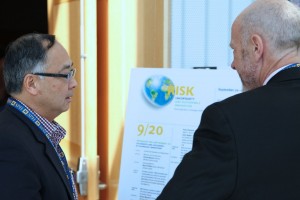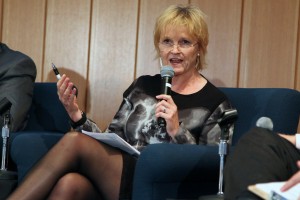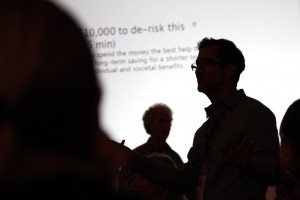Question: What do you get if you place some of the leading thinkers and practitioners in the fields of technology innovation, risk and sustainability in the same room for two days?
Answer: one whopping headache!
Not because of the confusion and cacophony, but because of the overwhelming volume of information, ideas and insights that emerge.
To be honest, my less than coherent state at the end of this weeks symposium on Risk, Uncertainty and Sustainable Innovation wasn’t helped by moderating eight discussion panels over two days, and coordinating a handful more. But without a doubt, this was a meeting that pushed the boundaries of how much a sane person can take in and remain sane.
 The idea behind the symposium was simple: Bring a bunch of smart people with different perspectives together to explore the complex intersections between risk, sustainability and innovation, and see what happens. In practice, we put together a format and a program that encouraged a candid exploration of realistic challenges and plausible approaches to developing sustainable applications of technology innovation, as well as using technology innovation to develop sustainable solutions to pressing problems.
The idea behind the symposium was simple: Bring a bunch of smart people with different perspectives together to explore the complex intersections between risk, sustainability and innovation, and see what happens. In practice, we put together a format and a program that encouraged a candid exploration of realistic challenges and plausible approaches to developing sustainable applications of technology innovation, as well as using technology innovation to develop sustainable solutions to pressing problems.
The result: Two ideas-packed days of engaging, inspiring and challenging discussion on how businesses, governments and others can better ensure safe, successful and sustainable outcomes from technology innovation.
Having been in the thick of the discussions, I’m still trying to unravel and assimilate a lot of the ideas that emerged. And I missed a lot of the nuances – much of the time I was too intent on keeping the conversation going to be fully aware of its content. Fortunately, the symposium was caught on video, and will be posted on the Risk Science Center’s Vimeo site in a week or so, so I will be able to revisit the discussions at my leisure. But I did want to capture some of my initial impressions here.
New ideas for new audiences. Something I did want to achieve with the symposium was to expose people to ideas they may not have previously come across. In this, the meeting was resounding success. While some of the ideas being explored on innovation, sustainability, risk and communication may have been old hat to people that live and breathe this stuff, there were many others in the room who were hearing things for the first time that had a direct bearing on their work.
Innovation relating to communication, informatics, processes and systems is more relevant than “named” emerging technologies. I had planned the first couple of sessions of the symposium to focus on technology innovation rather than risk, with the intention of ensuring the following discussions  were grounded in plausibility rather than wild speculation. I had expected these discussions to focus on the usual chestnuts – nanotechnology, synthetic biology, geoengineering, human enhancement etc. Instead, despite having experts in cutting edge emerging technologies on the panels, the discussion focused more on innovation in how we use knowledge and information – in areas like communication, informatics, processes and systems. When pressed, panelists felt that the labels new areas of technology attract are less important than innovations that are allowing things to be done in new ways.
were grounded in plausibility rather than wild speculation. I had expected these discussions to focus on the usual chestnuts – nanotechnology, synthetic biology, geoengineering, human enhancement etc. Instead, despite having experts in cutting edge emerging technologies on the panels, the discussion focused more on innovation in how we use knowledge and information – in areas like communication, informatics, processes and systems. When pressed, panelists felt that the labels new areas of technology attract are less important than innovations that are allowing things to be done in new ways.
Risk and risk communication float to the top. I was also intrigued to find that, try as I might, I could not keep risk and risk communication out of the conversation. Even the panels looking at emerging areas of technology innovation naturally gravitated to the challenges of understanding and addressing emerging risks, as well as communicating information on risks and benefits effectively.
A clear synergy exists between risk, innovation and sustainability. Although it was this synergy I wanted to explore through the symposium, I was surprised at how apparent it was that to many participants, successful technology innovation is critically dependent on taking an integrative approach to innovation, risk and sustainability.
There were also a number of personal highlights for me at the meeting, in addition to the discussion panels:
- John Viera – Director of Sustainability Environment and Safety Engineering at the Ford Motor Company – gave an inspiring talk on the company’s approach to sustainability.
- David Munson – the Robert J. Vlasic Dean of Engineering in the College of Engineering at the University of Michigan – beautifully articulated the need for integrative approaches to innovation and sustainability, as well as highlighting a number of innovative initiatives within the College of Engineering.
- James Wilsdon – Director of the Royal Society Science Policy Centre – gave a wonderful talk on technology innovation, going back to controversies over lightening rods in the 1700’s and highlighting how similar many of the issues we face today are to those society was facing three hundred years ago.
- Rodrigo Martinez and Mark Jones from the design company IDEO led delegates in a great team exercise in approaching challenges from different perspectives. I was particularly pleased with this session, as it demonstrated how design-inspired methodologies can be used to enable cross-expertise and innovative exploration of complex challenges.
- A panel of students and young professionals provided candid and insightful feedback on the first day’s proceedings – asking the questions and making the observations that more seasoned delegates were dying to ask and make, but were too scared to! A number of people commenting that it was the best session of the day.
 With the exception of the IDEO session, all of these talks will be available on Vimeo soon – along with the rest of the discussion panels.
With the exception of the IDEO session, all of these talks will be available on Vimeo soon – along with the rest of the discussion panels.
All in all, it seemed to be a highly successful meeting – although I still have a pile of evaluation forms that I haven’t dared look at yet. There were things that I would do differently next time – information overload was a major issue this year, and I’m not sure that giving myself so many panels to moderate was a great idea. But in terms of exposing people to new ideas and sparking new insights, things seened to go pretty well.
Hopefully now, some of those sparks will catch light and grow.
Further information on the symposium can be found here.
The full set of photos from the symposium can be viewed on Flickr.
Videos of keynotes and panel discussions will be available on Vimeo shortly.

I’m curious, what were the questions and observations that the seasoned delegates were dying to make but that the students and young professionals made instead?